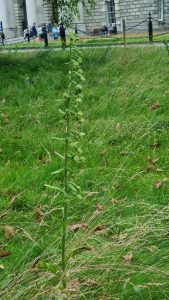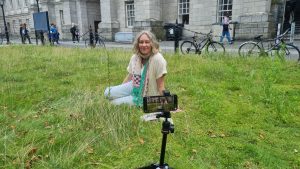By Prof. Jane Stout, Trinity College Dublin
The All-Ireland Pollinator Plan has been supporting and advocating #NoMowMay, an initiative to reduce the mowing regime in private and public lawns, and allow wildflowers to bloom, for several years, with some incredible results. This year, we enthusiastically embraced this at Trinity College Dublin, and have been blown away by what has popped up when we temporarily stopped mowing several of our own lawns.
 The most thrilling of more than 30 species to emerge from the usually closely mown lawns in Parliament Square (the two lawns just inside the Front Gate of Trinity, each with a birch tree at the centre) is a rare orchid, the broad-leaved helleborine Epipactis helleborine. Professor of Botany, Jenny McElwain (photographed), spotted the beautiful plant at the end of May, prompting Trinity to extend no mow May into June. In mid-June, another orchid was spotted by Craft Gardener Team Leader, John Parnell – the beautiful pink pyramidal orchid Anacamptis pyramidalis.
The most thrilling of more than 30 species to emerge from the usually closely mown lawns in Parliament Square (the two lawns just inside the Front Gate of Trinity, each with a birch tree at the centre) is a rare orchid, the broad-leaved helleborine Epipactis helleborine. Professor of Botany, Jenny McElwain (photographed), spotted the beautiful plant at the end of May, prompting Trinity to extend no mow May into June. In mid-June, another orchid was spotted by Craft Gardener Team Leader, John Parnell – the beautiful pink pyramidal orchid Anacamptis pyramidalis.
We knew that we would see clovers, trefoils, thistles and daisies come up in the lawns, but never expected to see not just one, but two species of orchid! How they ended up in the front lawns of Trinity is a bit of a mystery – either the tiny dust like seeds were blown or dropped here by birds, or the plants have lain dormant in the soil for decades, waiting for the opportunity to grow. What we do know is that the broad-leaved helleborine is a widely distributed but locally rare species, usually in woodlands, but it can cope with anthropogenic habitats. And, like most orchids, it needs a fungal partner for its seeds to germinate and for growth. One of the fungal partners of this orchid is also a common partner of birch trees, suggesting there is an underground connection between these orchids and the iconic birch trees in Front Square.
 And we know that the broad-leaved helleborine employs a range of insects as its pollinators. In fact, as if it couldn’t get any more exciting, as we were looking at the broad-leaved helleborine plants in late June, along came a pollinator – a wasp – visiting each of the flowers in the spike in turn for nectar. And broad-leaved helleborine nectar contains a cocktail of chemicals, including ones very similar to insect alarm pheromones, potentially to ward off hungry herbivores, and to attract pollinators. In fact, some of these chemicals are thought to intoxicate pollinators and prolong their flower visits, increasing the chances of successful pollination.
And we know that the broad-leaved helleborine employs a range of insects as its pollinators. In fact, as if it couldn’t get any more exciting, as we were looking at the broad-leaved helleborine plants in late June, along came a pollinator – a wasp – visiting each of the flowers in the spike in turn for nectar. And broad-leaved helleborine nectar contains a cocktail of chemicals, including ones very similar to insect alarm pheromones, potentially to ward off hungry herbivores, and to attract pollinators. In fact, some of these chemicals are thought to intoxicate pollinators and prolong their flower visits, increasing the chances of successful pollination.
What’s incredible to me is that all of this ecological interaction is happening right here in the middle of a capital city, in the heart of a human dominated habitat. This just goes to show that nature can persist, and recover, even in the most highly managed habitats. We just need to give it the space and time it needs.
Trinity’s overall ambition is to provide space for nature and nature recovery on our grounds, and to learn from and inspire nature-positive action by others. To this end, we’ve joined the Nature Positive Universities Network and hope that our no mow May success will inspire other organisations to join the nature recovery efforts.
 Jane has led the Plant-Animal Interactions research group at Trinity since 2003, and co-founded the All-Ireland Pollinator Plan with Úna Fitzpatrick, and is deputy chair of its steering group. She is now Trinity’s Vice-President for Biodiversity and Climate Action.
Jane has led the Plant-Animal Interactions research group at Trinity since 2003, and co-founded the All-Ireland Pollinator Plan with Úna Fitzpatrick, and is deputy chair of its steering group. She is now Trinity’s Vice-President for Biodiversity and Climate Action.
